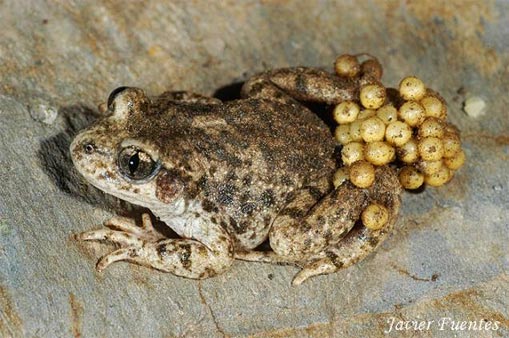Geckos Inspire New Method to Print Electronics on Complex Surfaces Geckos are masters at sticking to surfaces of all kinds and easily unsticking themselves, too. Inspired by these lizards, a team of engineers has developed a reversible adhesion method for printing electronics on a variety of tricky surfaces such as clothes, plastic and leather. Researchers from Northwestern University and the University of Illinois at Urbana-Champaign designed a clever square polymer stamp that allows them to vary its adhesion strength. The stamp can easily pick up an array of electronic devices from a silicon surface and move and print them on a curved surface. |  |





Si eres socio de la AHE puedes obtener el video: El eslizón de Chafarinas: (Chalcides parallelus) [videograbación] Edición: Parques Nacionales 2011 Descripción física: 1 DVD NIPO: 781110125.
Para obtener más información y realizar la solicitud accede al enlace:
https://www.herpetologica.es/index.php/video-eslizon-chafarinas
Accede a tu correo en herpetologica.org Si eres socio y no tienes cuenta de correo con nosotros, rellena el formulario pinchando aquí para obtener una. |  |
Electronic & Radar Engineer
Plant & Invertebrate Ecology Department
An electronic engineer and programmer is required to maintain, develop and operate unique radar systems to track flying insects. Main duties include:
- Maintain and run two Vertical Looking Radars, which monitor insect flight at high altitude.
- Maintain and run the Harmonic Radar, which is used to track individual flying insects at low altitude.
- Develop software and hardware to ensure these systems are kept up to date with technological innovations.
- Deploy and operate the harmonic radar for experiments on externally funded projects, either on Rothamsted estate or at external field sites.
- Liaise with biologists and mathematicians on modelling and interpretation of the data.
- Engage in writing papers and articles disseminating the results of the experiments.
- Explore innovative technologies to improve our ability to record insect behaviour and explore other areas of biologging technology within the context of agriculture.
Candidates will possess a degree and proven experience (or higher degree) in electronic engineering and radar systems. They will have an excellent understanding of the principles of radar and electronic systems, microwave measurements and RF antenna theory. Experience of interfacing electronic systems with computers is also required. They should also be able to design and modify equipment, and be interested in exploring new technologies. Candidates should have experience in the use of programming languages including BASIC and ‘C’.
The post-holder will be expected to conduct experiments during good weather, which may involve working outside of normal office hours. An interest in biological systems would be an advantage. Previous experience of Microsoft packages, database management and a driving licence are essential.
The level of appointment will be flexible dependant upon the skills and relevant experiences of the successful candidate, but starting salary is likely to be in the region of £33,780 to £37,534. This post is available for 3 years in the first instance, renewable thereafter.
Apply by application form only, available with further particulars from www.rothamsted.ac.uk or from the HR Group, Rothamsted Research, Harpenden, Herts, AL5 2JQ, rres.hr@bbsrc.ac.uk. Please quote ref: 1140.
Closing date: 14 October 2010
FECHAS Y HORARIOS: LUGAR: En la primera jornada se realizará un exhaustivo repaso a las especies presentes en Castilla-La Mancha, su distribución, sus problemas de conservación, así como una introducción teórica a los proyectos de seguimiento de fauna que actualmente desarrolla la Asociación Herpetológica Española (AHE), que aporta el profesorado de este curso. Más información aquí. |
 | La AHE, tras analizar el proyecto y consultar a sus asociados, ha enviado una serie de alegaciones al Proyecto de Real Decreto para el desarrollo del Listado de Especies Silvestres en Régimen de Protección Especial y del Catálogo Español de Especies Amenazadas. Dichas alegaciones se han presentado durante el plazo de exposición pública del proyecto. La Asociación Herpetológica Española lamenta profundamente que no se haya consultado a ninguna de las asociaciones profesionales, ecologistas o naturalistas para la realización de dicho proyecto. Creemos que la labor que dichas entidades están realizando en favor de la conservación de la naturaleza española es muy importante, siendo además éstas las poseedoras de la información más actualizada y real sobre nuestra fauna. Por otra parte lamentamos la premura y la falta de tiempo para analizar el proyecto ya que todo el proceso se ha llevado a cabo en periodo vacacional. Para ver el documento de alegaciones abrid el adjunto. |






